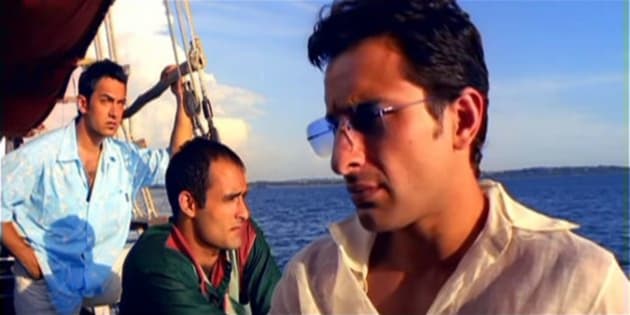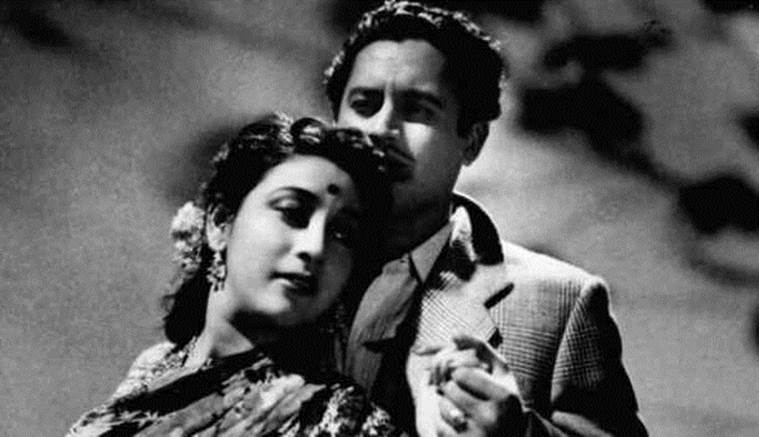Ivan Nagar curates a personal must-watch list.

Time and time again, people have asked me for Bollywood recommendations. This is not a simple task – a lot of great Bollywood films are so contextual that chunks are lost in cultural translation. This listicle will take that into account, and I will go over some films that provide a good entry point into Bollywood for non-Hindi speakers. This is in no way a ranking of the movies, but just a list of film recommendations, as varied as possible with regards to genres, topics and how old the films are.
1. Zindagi Na Milegi Dobara (2011)

In many ways, Zindagi Na Milegi Dobara is the perfect first Bollywood film to watch for any non-Hindi speaker as it offers a unique balance of Indian and European sensibilities unseen in many mainstream productions. Following three friends on a road trip across Spain, it is a simple road movie on the surface with a beautiful philosophical core that deepens one’s understanding with every re-watch. The film is accompanied with excellent music by Shankar Ehsaan Loy and lyrics & poems by Javed Akhtar, staple features of not just Bollywood, but Indian culture going back thousands of years.
2. Awara (1951)
Raj Kapoor is one of the greatest Indian filmmakers of all time, leaving behind arguably the biggest and most popular legacy. Awara is Kapoor’s magnum opus. A film that fantastically pays homage to Kapoor’s biggest influences – Orson Welles and the German expressionist movement (involving works such as from F. W. Murnau and Fritz Lang) – the cinematography and production design are a sight to behold, involving perhaps the most exceptional (and earliest) dream song sequences in Bollywood history. Awara‘s beloved soundtrack by legendary composers Shankar and Jaikishen with lyrics by the greatest poet of Indian cinema Shailendra, is still sung by millions of Indians, and is Indian cinema’s biggest and most successful export during the Soviet era. Even today after half a century, I often run into Eastern Europeans who knew the songs by heart and are big fans of Kapoor. Auteurs like Raj Kapoor are immortalised by their iconic cinema, and there is not a better example of it than Awara.
3. Do Bigha Zameen (1953)
London. Late 1940’s. Two relatively unknown filmmakers from India watched Vittorio De Sica’s humanistic masterpiece The Bicycle Thieves and are influenced to bring neo-realism to Indian cinema. One of them was Satyajit Ray, who went on to make his internationally renowned Pather Panchali, while the other was the equally talented but unfortunately overlooked Bimal Roy. Though both Pather Panchali and Roy’s Do Bigha Zameen are highly influenced by The Bicycle Thieves, they differ with regards to directors’ choice in cast. Roy chose to go for a known cast because of commercial reasons, while Ray stayed true to the neo-realistic roots and worked with non-professional actors. This is not to say the performances in Do Bigha Zameen aren’t realistic or grounded in humanity – in fact Balraj Sahni’s lead performance cannot be praised enough and would undoubtedly be counted amongst the few greatest Indian performances of all time. Do Bigha Zameen is a powerful human tragedy, immensely moving and has several heart-shatteringly beautiful scenes. It went on to become the first Indian film to get nominated for an Oscar for Best Foreign Language Film and for good reason, as rarely does one come across Hindi cinema as beautiful and timeless as this.
4. Udaan (2010)

A brilliant display of where small budgeted indie filmmaking is headed in India, Vikramaditya Motwane’s Udaan is a debut any filmmaker would be proud of. A film that boldly announced the arrival of one of present day’s most original and consistently good Indian directors, Udaan is a coming of age film set in modern small town India and is a depiction that is refreshingly honest and sometimes brutally so. The film features brilliant music by one of the most exciting composers working in Bollywood today, Amit Trivedi, and equally brilliant lyrics by Amitabh Bhattacharya.
5. Dangal (2016)
From low-budget indies, we jump straight to the highest-grossing Indian film in history, and behold the most commercially successful Indian actor of all time, Aamir Khan. Western audiences might know him from his 2001 Oscar nominated epic Lagaan, but Khan’s fame in East Asia has grown rapidly over the years, so much so that his films earn up to 10 times more in countries like China than they do in India. Dangal is a film with a social message that also packs a hefty dose of mainstream Bollywood entertainment, and Khan’s performance in particular is unbelievable, managing to astonish Indian audiences (and now Chinese audiences as well) every year with his chameleonic abilities as an actor.
6. Pyaasa (1957)
Raj Kapoor wasn’t the only Indian auteur to be influenced by Orson Welles. Another disciple of Welles was Guru Dutt, a director who possessed the ability to paint beautiful visual poetry on the canvas of cinema. Whether it’s blocking, framing or lighting, they all pay homage to Welles’ Citizen Kane. Pyaasa is Dutt’s most renowned masterpiece and one that has aged incredibly well, with it’s sociopolitical themes ringing as true today as they did back in the late 1950s, when India was in it’s constitutional adolescence. The soundtrack of Pyaasa is perhaps the greatest ever composed in Bollywood, pairing the legendary composer S.D. Burman with renowned poet and lyricist Sahir. Sahir’s piercingly observant lyrics managed to garner praise from then prime minister Jawaharlal Nehru, who was ironically criticised in them. Over the years, polls in several publications such as TIME Magazine and Sight and Sound have counted it amongst the best films of all time, so even though Guru Dutt may not have enjoyed much commercial success post-Pyaasa, his influence on Indian cinema will live on forever.
7. Kabhi Kabhie (1976)
No Bollywood listicle would be complete without a romantic film and no one in the history of Indian cinema mastered romance on screen like Yash Chopra. If one were to list the 10 most popular romantic Hindi films of all time, at least half would be credited to Yash Chopra – it comes as a surprise to learn he also managed to direct iconic non-romantic films like Deewar and Trishul in his career. Kabhi Kabhie came out at the peak of Chopra’s career, a time where he directed an amazing film almost every year and was operating at the top of his game. The music, direction and dialogues in particular are highlights of not just Kabhi Kabhie but Yash Chopra’s filmography. The film’s romantic core finds strength in the immortal songs penned by Sahir and a charming cast led by the talented Rakhee and the demigod of Hindi cinema, Amitabh Bachchan.
Since this is the only film on the list featuring Bachchan, I believe it’s fair to mention his iconic status in Indian pop culture. This is a man who has been leading films for over 50 years and remains one of 2-3 most popular Indians alive. For the last 32 years, fans of Bachchan swarmed his residence every Sunday just to see him come out and wave hello to them – such is the stardom of Amitabh Bachchan.
8. Lagaan (2001)
Lagaan probably has the most international exposure on this list, as it was famously the first Indian film in almost 50 years to be nominated for Best Foreign Language Film at the Oscars and garnered universal critical acclaim along with tremendous commercial success. Lagaan is a full blown Bollywood epic, one that Roger Ebert deemed ‘enormously entertaining’. I am in complete agreement with the claim: it manages to take all the usual ingredients of a mainstream Bollywood film and refines them to a degree of near perfection. A story set in colonial India about farmers being exploited by the British and how they settle matters by facing off on the cricket pitch, it almost sounds like an Indian fantasy. But Lagaan takes it’s unbelievable premise and grounds it with terrific performances (especially by Aamir Khan, who already has 2 films on this list), phenomenal music and a heartfelt story of the harsh colonial era in India.
9. Masaan (2015)
Masaan in many ways is the face of modern avant-garde Hindi cinema, and after premiering at Cannes in 2015 it went on to garner praise from all over. Unfortunately, as is the case with many great films, Masaan underperformed commercially. The script by first time screenwriter Varun Grover is superb and only second to the remarkable performances from the whole cast (in particular Vicky Kaushal). A story about individuals trying to escape the decay of small town urban India, it takes on heavyweight subjects such as the caste system, class divide, misogyny in society, and weaves them into one intertwining cathartic tale.
10. Sujata (1959)
Masaan wasn’t the first beautiful film taking on the caste system in India – Bimal Roy did it back in 1959 with Sujata. A tale of a lower caste orphan girl (Nutan) who is raised by an upper caste family and always made to feel the burden she bears by birth, Sujata is a tender but powerful takedown of the evils of the cast divide in India. It puts a mirror in front of the Indian audience and forces them to take note of their hypocritical and oppressive ways. Just like it’s predecessor on the list, Sujata too premiered at the Cannes Film Festival back in 1960, and even though it tackles subjects specific to India, I believe its emotional appeal remains universally accessible. Sujata‘s soundtrack by again, S.D. Burman, gave India one of the most popular lullabies of all time with its beautiful lyrics penned by Majrooh Sultanpuri.
11. Queen (2014)

Queen is the quintessential modern Indian feminist film, one that dismantles patriarchy in a way that is inoffensive enough for Indian audiences. Writer-director Vikas Bahl, like many influential Indian directors before him, understood that the best way to address the harshest of problems in society is through the humour that makes people look within once they stop laughing. Bahl was aided in his venture by Kangana Ranaut’s terrific lead performance, who along with actresses like Vidya Balan has brought a new wave of female-centric cinema to the mainstream of Bollywood. Queen doesn’t give us a ready-made strong female character. On the contrary, Ranaut convincingly depicts a plausible character arc of the titular working-class girl from Delhi, who finds herself in an unfortunate and unlikely situation but refuses to let life keep her down and embarks on a journey that is as much fun for the viewers as it is for her.
12. Salaam Bombay (1988)
The mention of Queen has provided us with an unintentional segue for this next entry, Salaam Bombay, which was the explosive debut of renegade filmmaker Mira Nair who has since become one of India’s biggest female directors. One could argue that Salaam Bombay isn’t a conventional ‘Bollywood’ film, in that it is not a part of the mainstream by any stretch of the imagination, but if so, could we say the same about the cinema of Guru Dutt and Hrishikesh Mukherjee? And if not, then what is it that separates the two? Mira Nair presents a stark realistic picture of the slums of Mumbai, a no holds-barred story about the grim realities of the city that the world usually associates with the glamour of the Hindi film industry.
13. Taare Zameen Par (2007)
With 2007’s Taare Zaamen Par, Aamir Khan proved that his talents not only lie in front of the camera but behind it as well. Khan has been notorious throughout his career for being extremely intrusive with the directors of his films, and all that backseat driving experience proved useful in his directorial debut, an unusually sure-footed and flawless first film for any director. Aamir Khan is a famously socially conscious artist, whether it’s hosting a TV show focused on social problems in India or constantly being involved with films that have strong sociopolitical statements to make. Taare Zameen Par is no exception. The film centres around a dyslexic child whose learning difficulty goes undiagnosed and is constantly labelled as ‘lazy’ and insincere, especially problematic in a country like India where parents often put a lot of pressure on their children to perform well academically. The film was immensely successful upon release, proving that Aamir had once again struck a chord within Indian audiences.
14. Mughal-e-Azam (1960)
In 2004, legendary film director Yash Chopra (of previously mentioned Kabhi Kabhie) made a film after 7 years. The hype for Chopra’s Veer-Zara was immense, bringing together top movie stars and a post-humous film score by exemplary music composer Madan Mohan. The same Friday as Veer-Zara, Mughal-e-Azam (English trans. The Great Mughals) was re-released in a fully restored colour version. What was amazing is that a film that was 44 years old at the time managed to give a tentpole release as stiff a competition at the box office as it did.
The production of Mughal-e-Azam is the stuff of legends, beginning in the 1940s with principal photography taking place only in the early 50s after a long period of pre-production disrupted by the India-Pakistan partition riots. The film’s financier also ended up relocating to Pakistan, which left Asif without any backer. When he finally managed to get the funds together, his old cast which consisted of heavy weights like actress Nargis had moved on to other projects, and Asif had to re-cast all the main players. Dilip Kumar was cast for the lead role, an actor widely considered the greatest to have ever graced Indian screens alongside stars like Madhubala and Prithviraj Kapoor. The film was shot in 3 languages so the filmmakers would shoot everything thrice, and on top of this as many as 14 cameras were used for some sequences, all of this contributing to sky high production costs. Principal photography took so long that during that time colour technology had arrived in India, and unable to restart the film from scratch but still wanting to shoot in colour, Asif shot a famous dance and song sequence in colour with the rest of the film in black and white. When Mughal-e-Azam finally hit cinemas in 1960, it had been 16 years in the making.
But the people were finally able to see Asif’s magnum opus, a story of an Indian prince rebelling against the Emperor Akbar for the courtesan he fell in love with. The film became so popular that most people to this day believe that the courtesan suffered the same fate in real life as she did in the film (Spoiler: She gets entombed alive). Mughal-e-Azam is not only the greatest epic ever to be made in India, but it is also a film with an unbelievably troubled production which is as fascinating as the film itself. Asif seemed to have been cursed with grand projects that went through unbelievable turbulence before completion – he went on to make only one more film and suffered an untimely death before it’s completion. At least we will always have Mughal-e-Azam to remember him by.
15. Dil Chahta Hai (2001)

Last but definitely not the least, we have Farhan Akhtar’s seminal Dil Chahta Hai. Arguably the strongest directorial debut in Hindi cinema, Dil Chahta Hai revolutionised Indian filmmaking in numerous ways, whether it was the gust of urban freshness it brought with it, or introducing basic concepts like a call sheet which was surprisingly not a thing in Bollywood until then. It is a coming of age story of 3 friends, Akash, Sid and Sameer, and includes all the main elements one expects from a Bollywood film, but in a way that appealed to urban elitists who looked down on Hindi movies in favour of Hollywood. For many people, Dil Chahta Hai was the first time they felt that a Bollywood movie could be relatable, cool and at the same time true to its mainstream roots.
This list was denser than I initially expected, but I sincerely hope it will make you seek out some good Hindi movies and discover a cinema that I believe is misrepresented or in many cases, caricatured, in the minds of Western audiences.















Somebody is a fan of Aamir Khan! And thank you for including ‘Queen’. Kangana Ranaut is an incredibly talented actress.
Hi Jowana,
Funnily enough I wouldn’t even consider myself an Aamir Khan fan, but the fact remains that the man has been involved (in different capacities) in some of the best Hindi films since his debut in 1989. I’m glad you liked my pick Queen! Hope you check out some of the other old ones 🙂
The content is great and perfect for what you’re trying to say. Awesome web site. Waiting for more posts on this article to read more. Keep up your excellency and efficiency in this same levels.
Thank you, glad you enjoyed the post 🙂
We plan on showing many of the classics in Birmingham with Don on BIG screen millennium Point 30 March 2019
Well explain.
Thanks for sharing this post with us. Truly you share nice post.